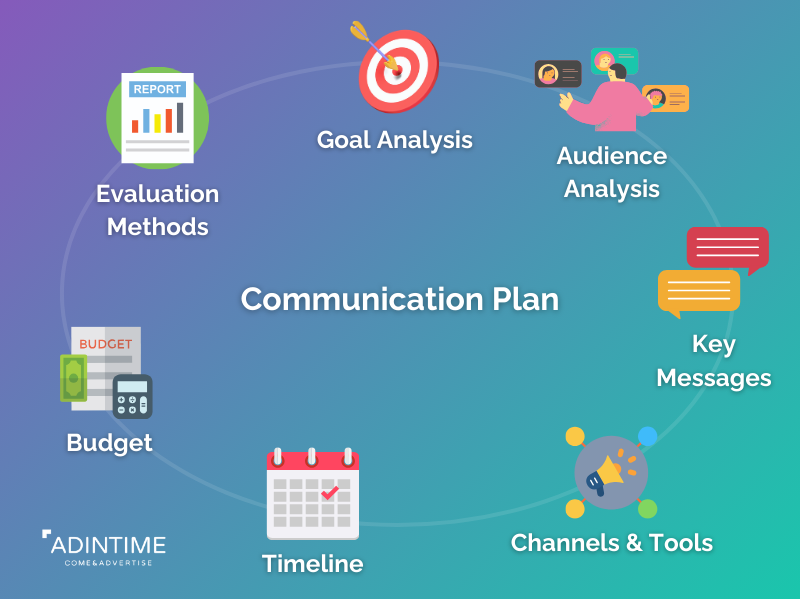What Is A Communication Plan? (Template Inlcuded)
Want to save time?
Summarize this article in seconds with AI
Communication Plan Definition
A communication plan is like a game plan for sharing information both inside and outside the organization. It outlines what you want to say, who you want to say it to, how you’ll get the message across, and when the most appropriate times to do it are. It helps companies to make sure everyone is on the same page and working towards the same goals. Think of it as a guide for getting your message out effectively so that it is understood correctly and keeping everyone engaged.
The Purpose of a Communication Plan
Communication plans are important for several reasons.
First, they make sure everyone in the team understands the organization's goals and strategies. This alignment increases efficiency and reduces confusion.
Second, having a clear communication strategy helps build and maintain strong relationships with stakeholders like customers, employees, and partners. It promotes trust and openness.
Lastly, a well-built communication plan is crucial for managing crises by offering a predefined approach to address issues quickly and effectively. So all stakeholders are not left hanging!
Key Components of a Communication Plan

A great communication plan template should have the following:
Goals and Objectives
Before we begin doing anything at all, we need to define what you want to achieve with your communication strategy. Is it to increase general brand awareness? Or to improve internal communication between employees and departments? Is it to launch a new product? We will need to clearly state and understand what we are after before we know what to do to get there!Audience Analysis
Next, we need to understand our audience. The more thorough the better. Identify who your messages are intended for—employees, customers, investors, or the general public. Knowing their characteristics and preferences can help us create messages that are going to resonate. For global marketing communication strategies, taking their culture into account is a must.Key Messages
These are the core ideas we want to convey. Our key messages should be clear, concise, and consistent with the overall objectives and branding. They serve as the foundation for all communication efforts, ensuring that the target audience receives a unified message across different platforms.Channels and Tools
Then, we need to choose the right channels and tools for delivering the messages. This could include:
- Emails: For direct and personalized communication.
- Social Media: To reach a broad audience quickly.
- Press Releases: For official announcements and media coverage.
- Newsletters: To provide regular updates to subscribers.
- Meetings and Events: For face-to-face interactions and engagement.Timeline
A timeline for when each piece of communication should happen needs to be in placed and followed . This helps in maintaining a steady flow of information and ensures that messages are delivered at optimal times for maximum impact.
Budget
Outline the financial resources allocated for each communication activity. This includes costs for content creation, advertising, events, and other related expenses. We need to make sure all actions are financially supported, justified, and sustainable.Evaluation Methods
Lastly, we need to come up with how we will track and measure results. This could involve tracking engagement rates, feedback, website traffic, or sales numbers. Regular evaluation allows us to refine your strategy and improve future communication plans.
Common Mistakes When Developing Communication Plans
Avoid these common mistakes to maximize the chance of success of your communication plan:
- Unclear Objectives: Without specific and well-defined goals, it's difficult to measure the effectiveness of the communication efforts.
- Neglecting Audience Preferences: Failing to consider your audience's preferences can lead to ineffective communication.
- Inconsistent Messaging: Inconsistencies can confuse your audience and weaken your message.
- Lack of Evaluation: Without proper evaluation protocol in place, you won't know if your communication strategies are working or where it needs improvement.
- Inadequate Budgeting: Not allocating sufficient resources can limit your communication efforts and reach.
Marketing Communication Plan Template
The purpose of this communication plan is to establish a structured approach for promoting our wellness programs, engaging with our audience, and ensuring clear internal communication. This plan outlines the goals, key messages, target audience, channels, timeline, budget, and evaluation methods.
Primary Goals:
- Increase brand awareness by 20% over the next year.
- Enroll 500 new participants in our wellness programs within six months.
- Enhance internal communication to ensure all employees are informed about company updates and wellness initiatives.
Specific Objectives:
- Launch a new digital marketing campaign to promote our wellness programs.
- Organize monthly wellness webinars to engage potential participants.
- Implement a quarterly newsletter to keep employees updated on company news and wellness tips.
External Audience:
- Potential Customers: Individuals seeking wellness programs, aged 25-45, health-conscious, tech-savvy.
- Current Customers: Existing participants in our wellness programs.
- Partners: Gyms, yoga studios, health food stores, and corporate wellness programs.
Internal Audience:
- Employees: Staff across all departments, ensuring they are aligned with company goals and wellness initiatives.
External:
- "Achieve your wellness goals with our personalized programs."
- "Join our community and transform your health journey."
- "Discover the benefits of holistic wellness with our expert-led webinars."
Internal:
- "Stay informed and engaged with our quarterly wellness newsletter."
- "Participate in our company wellness challenges to enhance your health."
- "Your feedback matters! Help us improve our wellness initiatives."
External Channels:
- Social Media: Facebook, Instagram, Twitter for regular updates and engagement.
- Email Marketing: Weekly newsletters and promotional emails.
- Website: Dedicated landing pages for wellness programs and resources.
- Webinars: Monthly expert-led wellness sessions.
- Partnerships: Collaborations with local gyms, yoga studios, and health food stores.
Internal Channels:
- Intranet: Centralized platform for company news and updates.
- Email: Regular internal memos and newsletters.
- Meetings: Monthly all-hands meetings to discuss updates and gather feedback.
Bulletin Boards: Physical boards in common areas for wellness tips and event announcements.
Launch Phase (Month 1-2):
- Develop content for social media and email campaigns.
- Set up the webinar platform and schedule the first session.
- Create and distribute the first internal newsletter.
Implementation Phase (Month 3-12):
- Roll out the digital marketing campaign.
- Host monthly webinars and engage participants.
- Distribute weekly newsletters and monitor engagement.
- Hold monthly all-hands meetings and gather employee feedback.
- Update the intranet and bulletin boards regularly.
Evaluation Phase (Ongoing):
- Track key metrics and adjust strategies as needed.
- Conduct quarterly reviews to assess progress and make necessary changes.
External Communication:
- Social Media Advertising: $5,000/month
- Email Marketing Software: $300/month
- Webinar Platform Subscription: $200/month
- Content Creation (Graphics, Videos): $2,000/month
- Partnership Collaborations: $1,000/month
Internal Communication:
- Newsletter Production: $500/quarter
- Intranet Maintenance: $200/month
- Meeting Expenses: $300/month
- Bulletin Board Updates: $100/month
External:
- Social Media Metrics: Engagement rates, follower growth, click-through rates.
- Email Marketing Metrics: Open rates, click-through rates, conversion rates.
- Webinar Metrics: Registration numbers, attendee engagement, feedback.
- Website Metrics: Traffic, bounce rates, conversion rates.
Internal:
- Employee Surveys: Quarterly surveys to gather feedback on internal communication.
- Newsletter Metrics: Open rates, click-through rates, feedback.
- Meeting Feedback: Attendance rates, feedback from participants.
 Cookie preferences
Cookie preferences








 Xiaohongshu Advertising Guide: How Can Hong Kong Brands Maximize Their Results?
Xiaohongshu Advertising Guide: How Can Hong Kong Brands Maximize Their Results?
 2x your advertising effectiveness: Master big data to optimize ad ROI
2x your advertising effectiveness: Master big data to optimize ad ROI
 Top 5 Best Ads in 2025 in Hong Kong
Top 5 Best Ads in 2025 in Hong Kong
 Hong Kong Outdoor Advertising Cost in 2026 | Adintime Report
Hong Kong Outdoor Advertising Cost in 2026 | Adintime Report
 Marketing Calendar 2026: Key Dates For Marketing Success
Marketing Calendar 2026: Key Dates For Marketing Success
 The Most Widely-Read Magazine and Newspaper in Hong Kong
The Most Widely-Read Magazine and Newspaper in Hong Kong
 Understanding YouTube Advertising Costs in 2025
Understanding YouTube Advertising Costs in 2025
 OOH /DOOH advertising in Hong Kong: Formats and Rates (2025 Update)
OOH /DOOH advertising in Hong Kong: Formats and Rates (2025 Update)
 How much does LinkedIn Advertising Cost? (2025 Update)
How much does LinkedIn Advertising Cost? (2025 Update)
 Press Ad Basics: Types, Formats and Ad Price
Press Ad Basics: Types, Formats and Ad Price